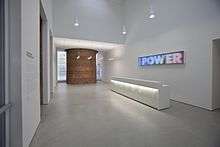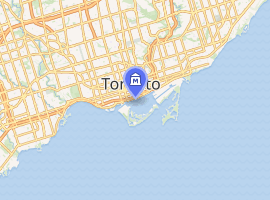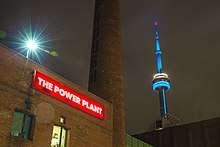The Power Plant
The Power Plant Contemporary Art Gallery a Canadian non-collecting public gallery devoted to contemporary art, located in Toronto, Ontario at Harbourfront Centre. The Power Plant is a registered Canadian charitable organization supported by its members, sponsors, donors, and funding bodies at all levels of government.
 | |

| |
| Established | 1987 |
|---|---|
| Location | 231 Queens Quay West, Toronto, Ontario, Canada |
| Coordinates | 43°38′18.33″N 79°22′55.42″W |
| Type | Art gallery |
| Visitors | 130,000 per year |
| Director | Gaëtane Verna[1] |
| President | Jacques Bernier |
| Curator | Justine Kohleal, (Assistant Curator of Exhibitions); Amin Alsaden (Nancy McCain & Bill Morneau Curatorial Fellow) Josh Heuman, (Education and Public Programs); Laura Demers (TD Curator of Education & Outreach Fellow) |
| Public transit access | ■ Union 509 Harbourfront 510 Spadina |
| Website | thepowerplant |
Initially established as the Art Gallery at Harbourfront in 1976, the Power Plant was officially opened in 1987 in its current location. Over its history, the gallery has presented new and recent work by living Canadian and international artists, mounting major solo shows and thematic exhibitions by artists such as AA Bronson, John Akomfrah, Terry Adkins, Carlos Amorales, Yto Barrada, Patrick Bernatchez, Christian Boltansky, Janet Cardiff, Peter Doig, Latifa Echakhch, Geoffrey Farmer, Jack Goldstein, Ann Hamilton, Leslie Hewitt, Thomas Hirschhorn, Zhang Huan, Maria Hupfield, Mike Kelley, Shelagh Keeley, Micah Lexier, Duane Linklater, Liz Magor, Christian Marclay, Kelly Mark, Emily Mast, Steve McQueen, Kent Monkman, Mike Nelson, Adrian Piper, Ed Poitras, Annie Pootoogook, Pedro Cabrita Reis, Pedro Reyes, Michael Snow, Jana Sterback, Derek Sullivan, Superflex, Ryan Trecartin, Ian Wallace, Franz Erhard Walther, Lawrence Weiner, Akram Zaatari, Zineb Sedira, Amalia Pica, Vivian Suter, Shuvinai Ashoona, Omar Ba, Alicia Henry, Joana Hadjithomas and Joreige Khalil, Rashid Johnson, Naeem Mohaiemen, Vincent Meessen, Hajra Waheed, among others.
In addition to presenting exhibitions, the gallery hosts educational programs and events for the public, and produces artist books, editions and publications for research and dissemination. Since its foundation in 1987, the Power Plant has produced more than forty publications.[2]
Background
The Power Plant Contemporary Art Gallery is a Canadian non-collecting, public art gallery dedicated exclusively to contemporary visual art from Canada and the world. It is a forum for the advanced artistic culture that offers a facility and professional support to a diverse group of living artists while engaging equally diverse audiences in their work. The Power Plant fulfills its mandate by generating: exhibitions that represent the range of advanced practice in visual arts; publications that provide in-depth explorations of contemporary art; lectures and symposia that encourage debate and further understanding; interpretative tools that invite visitors to question, explore and reflect upon their experiences; programming that incorporates other areas of culture at their intersection with visual art.
History
In 1976, Harbourfront Centre established the Art Gallery at Harbourfront, housed at the Bill Boyle Artport. Its founding director was Anita Aarons. Harbourfront Corporation provided the Art Gallery at Harbourfront with the opportunity to renovate the powerhouse on site as its new home. Constructed in 1926, the original powerhouse (and the Power Plant's current facility) housed the heating and refrigeration equipment for the massive Toronto Terminal Warehouse (now Queen's Quay Terminal) and its companion building, The Ice House (today Harbourfront Centre Theatre).

Peter Smith of Lett/Smith Architects was chosen to undertake the renovations, the design of which took into consideration both the history of the building and the demands on a contemporary art venue. Opened to the public on 1 May 1987, the Power Plant is easily recognized by its smokestack and exterior façade, both of which have been restored to maintain reference to its history.
In celebration of the Power Plant's 25th anniversary in 2012, the gallery introduced ALL YEAR, ALL FREE, offering free admission and open access to the public to all exhibitions. The Power Plant also marked the occasion with a redesign of its visual identity and added a new lobby, retail space and website, thus strengthening its position locally and internationally and allowing audiences to further engage with the rich and rewarding work of contemporary artists and thinkers. The gallery celebrated its 30th anniversary in 2017, coinciding with Canada's Sesquicentennial.
Harbourfront Centre
The Power Plant is a key attraction of Harbourfront Centre. While the gallery is led by its own Board of Directors, Harbourfront Centre supports the gallery with maintenance and improvements to the physical site, as well as services and financial support.
For more than three decades, Harbourfront Centre has been at the cutting edge of all that is current and creative, bringing together the best in both in Canadian multiculturalism and around the world. From its beginnings as "Harbourfront Corporation," a federal Crown Corporation established in 1972, Harbourfront Centre was formed on January 1, 1991 as a non-profit charitable organization with a mandate to organize and present public events and to operate a ten-acre site on Toronto's lakefront, encompassing York Quay and John Quay (south of Queens Quay West). Since its inception, Harbourfront Centre has been introducing audiences to artists and art forms that would not normally be seen in commercial venues, exploring new and bold frontiers in the arts and creative expression
Board of Directors
The Power Plant's Board of Directors includes professionals and noted individuals from a broad range of industries, including the arts, education, finance, law, philanthropy, public service and real estate.
Past directors
- Gaetane Verna (2012–Present)
- Gregory Burke (2005 - 2011)
- Wayne Baerwaldt (2002 - 2004)
- Marc Mayer (1998 - 2001)
- Steven Pozel (1992 - 1997)
- Allan MacKay (1989 - 1991)
- William J. S Boyle (1987 - 1988)
Exhibitions
Since its earliest exhibitions, the Power Plant has been dedicated to presenting new and recent work by Canadian artists along with their international peers, including ambitious thematic exhibitions and major solo exhibitions by Canadian artists such as Peter Doig, Geoffrey Farmer, Maria Hupfield and Annie Pootoogook. Solo exhibitions by international artists have included Fiona Banner, Pedro Cabrita Reis, Akram Zaatari and more.
The Power Plant considers it crucial to pair Canadian and international artists (and their subject matter) to position the gallery in the local-global dialogue of contemporary art practice and to attract a culturally diverse audience.
Christian Marclay's The Clock, a world-renowned video called "a masterpiece of our time" by The Guardian,[3] opened at the Power Plant in Fall 2012 after screenings at London's White Cube Gallery and New York's Paula Cooper Gallery, among other venues. The gallery partnered with Nuit Blanche to present special overnight hours and marathon viewings of the exhibition for the public. Toronto-based artist Micah Lexier's exhibition [One, Two and More than Two in Fall 2013, called a "landmark [exhibition]" by Toronto Star,[4] involved the participation of 101 artists/duos/collectives from in and around Toronto, presenting a wide-ranging, multi-generational portrait of a robust Toronto art community. Shelagh Keeley's Fall 2014 Fleck Clerestory Commission, Notes on Obsolescence, was acquired by the Vancouver Art Gallery. Also during Fall 2013, the Power Plant presented Toronto-born, Brooklyn-based artist Julia Dault’s first solo museum exhibition and monograph, Colour Me Badd. Dault’s work has been acquired by the Solomon R. Guggenheim Museum, New York, as well as the Art Gallery of Ontario, Toronto. Unfinished Conversation: Encoding/Decoding in Winter 2015 presented the work of Terry Adkins (US), John Akomfrah (UK), Sven Augustijnen (Belgium), Steve McQueen (UK), Shelagh Keeley (Canada) and Zineb Sedira (Algeria/France/UK), six artists whose practice is devoted primarily to commenting on history and memory. What connects all these artworks is the artists’ involvement with significant social issues confronting humanity today, and their profound desire to push formal boundaries in order to tackle them. Toronto Star described the exhibition as "Powerful, convincing and emotionally resonant".[5]
To further the reach and impact of the Power Plant's exhibitions, the gallery began to present virtual tours for online audiences unable to visit in person and to travel its exhibitions.
In 2019 Hajra Waheed, one of The Power Plant's Fall 2019 exhibiting artists presented a related exhibition on view at the Small Arms Inspection Building as a part of Toronto Biennial of Art.
Commissioning Program
In 2006, the Power Plant launched an annual Commissioning Program, which is an ongoing program to develop and premier major new works by Canadian and international artists.[6] In 2014, the gallery introduced the Fleck Clerestory Commissioning Program in a gallery space dedicated solely to one site-specific installation each year, inaugurated by Toronto-based artist Shelagh Keeley.
The commissions reflect international, national and local dialogues, with content that references the specificity of Toronto's historical past and a global cultural present, all the while involving the local arts community and the general public. Commissioned works have since been acquired by national collecting institutions, toured to other galleries of significance outside Canada, and contributed to the cultural life of the region.
Past commissions include:
- Rashid Johnson: Anxious Audience (2019)
- Hajra Waheed: Hold Everything Dear (2019)
- Vincent Meessen: Blues Klair (2019)
- Thomas J Price: Ordinary Men (2019)
- Omar Ba: Same Dream (2019)
- Karla Black (2018)
- Beth Stuart: Length, Breadth, Thickness and—Duration (2018)
- Abbas Akhavan: variations on a landscape (2018)
- Kader Attia: The Field of Emotion (2018)
- Michael Landy: DEMONSTRATION (2017)
- Amalia Pica: ears to speak of (2017)
- Maria Hupfield: The One Who Keeps On Giving (2017)
- Kapwani Kiwanga: A wall is just a wall (2017)
- Latifa Echakhch: Cross Fade (2016)
- Maria Loboda: Some weep, some blow flutes (2016)
- Carlos Amorales: Black Cloud (2015)
- Tercerunquinto: Mine (2015)
- Bik Van der Pol: Eminent Domain (2015)
- YES! Association: (art)work(sport)work(sex)work (2015)
- Nadia Belerique, Laurie Kang, Lili Huston-Herterich: The Mouth Holds the Tongue (2015)
- Shelagh Keeley: 1983 Kisangani Zaire (2015)
- Shelagh Keeley: Notes on Obsolescence (2014)
- Vasco Araújo: Retrato (2014)
- Mike Nelson: Amnesiac Hide (2013)
- Jimmy Robert: Draw the Line (2013)
- Derek Sullivan: Albatross Omnibus (2011)
- Ian Wallace: Abstract Paintings I–XII (The Financial District) (2010)
- Pae White: Sea Beast (2010)
- Candice Breitz: Factum (2009)
- Lawrence Weiner: CUL-DE-SAC (2009)
- Scott Lyall: The Power/Color Ball (2008)
- Simon Starling: Infestation Piece (Musselled Moore) (2008)
- Rafael Lozano-Hemmer: Pulse Front (2007)
Public programs & outreach
In an effort to further the dialogue around access to contemporary art practices, the Power Plant opens the galleries and programs – including exhibitions, educational and public programs, and collaborative events – to wider audiences.
The Power Plant organizes approximately 120+ educational programs for the public annually. These include artist talks, gallery tours, lecture, symposia, film screenings, Power Kids art workshops for children, youth engagement and outreach programs such as Power Youth, and more.[7]
Publications & artist editions
To further the dialogue around contemporary art and art practices, the Power Plant produces publications, artist books and exhibition catalogues to accompany the shows.[8]
Past publications include:[9]
- Julia Dault (2019)
- Amalia Pica: please listen hurry others speak better (2018)
- The Unfinished Conversation: Encoding / Decoding (2016)
- Yto Barrada: A Guide to Fossils for Forgers and Foreigners (2016)
- Ulla von Brandenburg: It Has a Golden Red Sun and an Elderly Green Moon (2016)
- Pedro Cabrita Reis: fourteen paintings the preacher and a broken line (2016)
- Micah Lexier: More Than Two (Let It Make Itself) (2013)
- Derek Sullivan: Albatross Omnibus (2011)
- Kerry Tribe: Speak Memory (2012)
- Glenn Ligon: Some Changes (2005)
The Power Plant also produces artist editions. Past editions have included works by Rashid Johnson, Mario Pfeifer, Thomas J Price, Omar Ba, Shuvinai Ashoona, Vivian Suter, Franz Erhard Walther, Ulla von Brandenburg, Lawrence Weiner, Micah Lexier, Wim Delvoye, Marcel Dzama, Pae White, Brian Jungen, Ian Wallace and more.[10]
References
- "Message from the Director - The Power Plant". The Power Plant. The Power Plant. Retrieved 28 November 2011.
- "OAAG Award". OAAG. OAAG. Retrieved 23 September 2011.
- Bradshaw, Peter (7 April 2011). "Christian Marclay's The Clock: a masterpiece of our times". The Guardian. Retrieved 14 June 2019.
- Whyte, Murray (September 24, 2013). "At the Power Plant, All Together Now | The Star". thestar.com. Retrieved 14 June 2019.
- Whyte, Murray (January 28, 2015). "Colonialism, continued in arresting new Power Plant show | The Star". thestar.com. Retrieved 14 June 2019.
- "The Power Plant - 2011 Commission". The Power Plant. The Power Plant. Retrieved 23 September 2011.
- "The Power Plant: Programs & Events".
- "The Power Plant: Shop".
- "The Power Plant: Publications".
- "The Power Plant: Artist Editions".